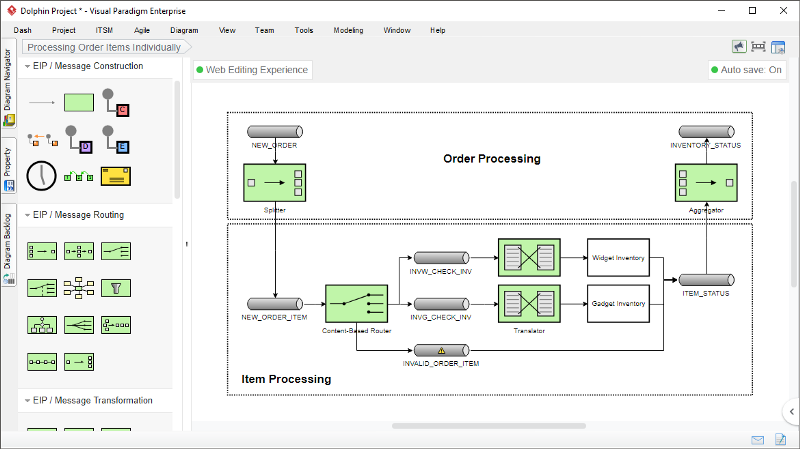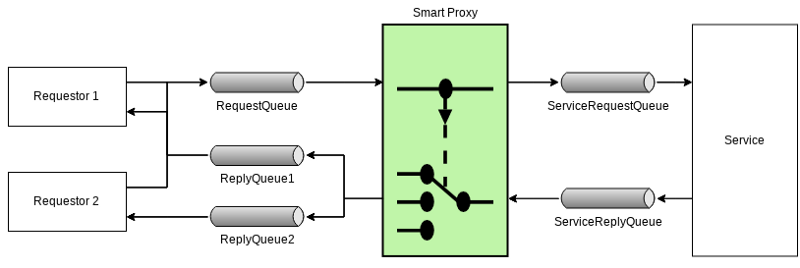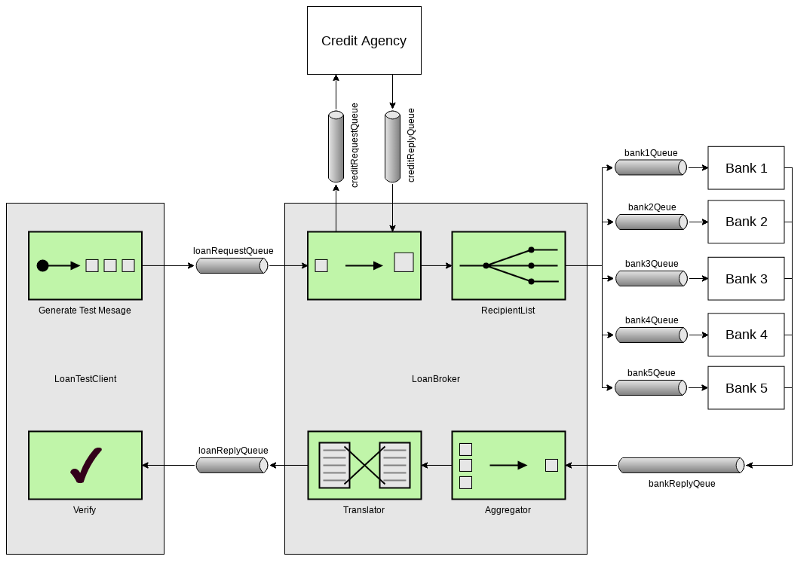Enterprise Integration Patterns (EIP)is a book by Gregor Hohpe and Bobby Woolf and describes 65 patterns for the use of enterprise application integration and message-oriented middle-ware in the form of a pattern language. They help us use standardized ways to integrate applications, no need to reinventing the wheel each time you have a problem.
The goal of Enteprise Integration patterns is to create a common language and a set of workflow actions in order to combine then together to create mature, practical business process. It provides an catalog of sixty-five patterns that help you to design effective messaging solutions for your enterprise.
The book distinguishes four top-level alternatives for integration:
- File Transfer
- Shared Database
- Remote Procedure Invocation
- Messaging
The following integration types are introduced:
- Information Portal
- Data Replication
- Shared Business Function
- Service Oriented Architecture
- Distributed Business Process
- Business-to-Business Integration
- Tightly Coupled Interaction vs. Loosely Coupled Interaction
Draw Enterprise Integration Pattern Diagram with Free Online Tool
Visual Paradigm’s free Enterprise Integration Patterns tool (EIP diagram tool) features a set of editing features that makes diagramming simpler and faster such as drag-and-drop and alignment guide make editing smooth and intuitive. The EIP diagram tool also comes with a set of EIP symbols and shapes that let you create different kinds of EIP diagrams.

You can easily develop your patterns and then output and share them via formats like PNG, JPG, GIF, SVG and PDF.
Learn EIP with Examples and Templates
You may start with a blank diagram or a EIP template. Followings are few of the templates. Click the Edit button to start editing straight away. It’s free and no registration needed.
Enterprise Integration Pattern Example: Smart Proxy

Enterprise Integration Pattern Example: Composed Messaging MSMQ

Want to Adopt some other Enterprise Integration Patterns?
EIP Online Editing Repository from Visual Paradigm
Implementation Framework for EIPs
Apache Camel supports most of the Enterprise Integration Patterns from the excellent book by Gregor Hohpe and Bobby Woolf. Based on Enterprise Integration Patterns (EIP) to help you solve your integration problem by applying best practices out of the box. Camel supports most of the Enterprise Integration Patterns from the excellent book by Gregor Hohpe and Bobby Woolf, and newer integration patterns from microservice architectures.
If you are new to Camel you might want to try the Getting Started in the User Guide before attempting to implement these patterns.
MESSAGING SYSTEMS

Message Channel
How does one application communicate with another using messaging?

Message
How can two applications connected by a message channel exchange a piece of information?

How can we perform complex processing on a message while maintaining independence and flexibility?

How can you decouple individual processing steps so that messages can be passed to different filters depending on a set of conditions?

How can systems using different data formats communicate with each other using messaging?

How does an application connect to a messaging channel to send and receive messages?
MESSAGING CHANNELS

How can the caller be sure that exactly one receiver will receive the document or perform the call?

How can the sender broadcast an event to all interested receivers?

What will the messaging system do with a message it cannot deliver?

How can the sender make sure that a message will be delivered, even if the messaging system fails?

How can you connect an application to the messaging system so that it can send and receive messages?

How can multiple messaging systems be connected so that messages available on one are also available on the others??

What is an architecture that enables separate applications to work together, but in a de-coupled fashion such that applications can be easily added or removed without affecting the others?

Data synchronization by capturing changes made to a database, and apply those changes to another system.
MESSAGE CONSTRUCTION

How can messaging be used to transmit events from one application to another?

When an application sends a message, how can it get a response from the receiver?

How does a replier know where to send the reply?

How does a requestor that has received a reply know which request this is the reply for?

How can a sender indicate when a message should be considered stale and thus shouldn’t be processed?
MESSAGE ROUTING

How do we handle a situation where the implementation of a single logical function (e.g., inventory check) is spread across multiple physical systems?

How can a component avoid receiving uninteresting messages?

How can you avoid the dependency of the router on all possible destinations while maintaining its efficiency?

How do we route a message to a list of (static or dynamically) specified recipients?

How can we process a message if it contains multiple elements, each of which may have to be processed in a different way?

How do we combine the results of individual, but related messages so that they can be processed as a whole?

How can we get a stream of related but out-of-sequence messages back into the correct order?

How can you maintain the overall message flow when processing a message consisting of multiple elements, each of which may require different processing?
How do you maintain the overall message flow when a message needs to be sent to multiple recipients, each of which may send a reply?

How do we route a message consecutively through a series of processing steps when the sequence of steps is not known at design-time and may vary for each message?

How do we route a message through multiple processing steps when the required steps may not be known at design-time and may not be sequential?

How can you decouple the destination of a message from the sender and maintain central control over the flow of messages?
How can I throttle messages to ensure that a specific endpoint does not get overloaded, or we don’t exceed an agreed SLA with some external service?
How can I sample one message out of many in a given period to avoid downstream route does not get overloaded?
How can I delay the sending of a message?
How can I balance load across a number of endpoints?
How can I stop to call an external service if the service is broken?
How can I call a remote service in a distributed system where the service is looked up from a service registry of some sorts?
How can I define a series of related actions in a Camel route that should be either completed successfully (all of them) or not-executed/compensated?
How can I route a message to a number of endpoints at the same time?
How can I repeat processing a message in a loop?
MESSAGE TRANSFORMATION

How do we communicate with another system if the message originator does not have all the required data items available?

How do you simplify dealing with a large message, when you are interested only in a few data items?

How can we reduce the data volume of message sent across the system without sacrificing information content?

How do you process messages that are semantically equivalent, but arrive in a different format?
How can I sort the body of a message?
How do I execute a script which may not change the message?
How can I validate a message?
MESSAGING ENDPOINTS
How do you move data between domain objects and the messaging infrastructure while keeping the two independent of each other?

How can an application automatically consume messages as they become available?

How can an application consume a message when the application is ready?

How can a messaging client process multiple messages concurrently?

How can multiple consumers on a single channel coordinate their message processing?

How can a message consumer select which messages it wishes to receive?

How can a subscriber avoid missing messages while it’s not listening for them?
How can a message receiver deal with duplicate messages?

How can a client control its transactions with the messaging system?

How do you encapsulate access to the messaging system from the rest of the application?

How can an application design a service to be invoked both via various messaging technologies and via non-messaging techniques?
SYSTEM MANAGEMENT

How can we effectively administer a messaging system that is distributed across multiple platforms and a wide geographic area?

How can you route a message through intermediate steps to perform validation, testing or debugging functions?

How do you inspect messages that travel on a point-to-point channel?
How can we effectively analyze and debug the flow of messages in a loosely coupled system?
How can I log processing a message?
Steps groups together a set of EIPs into a composite logical unit for metrics and monitoring.

